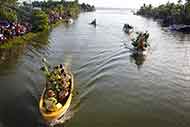Welcome to Belize
Formerly British Honduras, Belize is a country of diverse cultures, language and ethnic groups. Mostly English speaking, Belize is warm, friendly, and relatively inexpensive (with some notable exceptions.)
The People of Belize

Garifuna Settlement Day
Belize is the most sparsely populated nation in Central America. It is larger than El Salvador and compares in size to the State of Massachusetts. Slightly more than half of the population lives in rural areas. About one-fourth live in Belize City, the principal port, commercial center, and former capital. More than one-third of the population is comprised of persons younger than 14 years of age.
Most Belizeans are of multiracial descent. About 43.7% of the population is of mixed Mayan and European descent (Mestizo); 29.8% are of African and Afro-European (Creole) ancestry; about 11.0% are Mayan; and about 6.6% are Afro-Amerindian (Garifuna). The remainder, about 8.9%, includes European, East Indian, Chinese, Middle Eastern, and North American groups.
English, the official language, is spoken by virtually all except the refugees who arrived during the past decade. Spanish is the native tongue of about 50% of the people and is spoken as a second language by another 20%. The various Mayan groups still speak their indigenous languages, and an English-Creole dialect similar to the Creole dialects of the English-speaking Caribbean Islands is spoken by most. The rate of functional literacy is 76%. About 50% of the population is Roman Catholic; the Anglican Church and other Protestant Christian groups account for most of the remaining 50%. Mennonite settlers number about 8,500.
Brief History of Belize
The Mayan civilization spread into the area of Belize between 1500 BC and AD 300 and flourished until about AD 1200. Several major archeological sites--notably Caracol, Lamanai, Lubaantun, Altun Ha, and Xunantunich--reflect the advanced civilization and much denser population of that period. European contact began in 1502 when Christopher Columbus sailed along the coast. The first recorded European settlement was established by shipwrecked English seamen in 1638. Over the next 150 years, more English settlements were established. This period also was marked by piracy, indiscriminate logging, and sporadic attacks by Indians and neighboring Spanish settlers.
Great Britain first sent an official representative to the area in the late 18th century, but Belize was not formally termed the "Colony of British Honduras" until 1840. It became a crown colony in 1862. Subsequently, several constitutional changes were enacted to expand representative government. Full internal self-government under a ministerial system was granted in January 1964. The official name of the territory was changed from British Honduras to Belize in June 1973, and full independence was granted on September 21, 1981.
Belize has an unparalleled uniqueness of geographic and wildlife diversity. It offers visitors the very best of the Central American and Caribbean worlds. On the Belize mainland, the rain forests provide a unique opportunity to observe life in all of its manifold and perplexing beauty, including rare and beautiful tropical birds and elusive cats, underwater caves, impressive rivers and majestic waterfalls. Mystical Maya Sites with their temples towering above the surrounding jungle add mystery to the majesty of this unusual and complex ecosystem.

Map of Belize
Offshore you can visit hundreds of island cayes (pronounced keys) or three of the Caribbean's four coral atolls. Belize is also home of the word's 2nd longest barrier reef. Nearly 160 miles long, the reef runs from the border with Mexico, where it is only 1/2 mile offshore, south to the Sapodilla Cayes, which lie some 30 miles from the mainland. In a single day you can enjoy the serenity of a lush tropical forest and visit the longest barrier reef in the Western Hemisphere.
Unlike Mexico, a foreigner in Belize can buy land. Yes, you will own it outright with fully marketable title! It's yours, it's in your name and you can pass it on to your heirs.
Here is a preview of the valuable information about Belize you will find on Consejo.bz:
General Belize Information
Find out about passport and visa requirements, Border Crossing, money exchange and more to help you enjoy your visit to Belize.
Belize Real Estate
For Sale Or Rent in the Consejo Area
The Wildlife of Belize
Belize is home to a large array of wildlife, including the elusive jaguars.
Traveling Around Belize
Join us as we visit sites in this beautifully diverse country.
Land of The Maya
The Maya dominated what is now Central America for more than 1,500 years. Then, the Maya civilization disappeared! We have visited several Maya Sights in Belize, Mexico and Guatemala.
Mexico
We have traveled a lot through Mexico's Yucatan and near by states. Here are a few of the places we have visited along with some Mexican Information and History.
